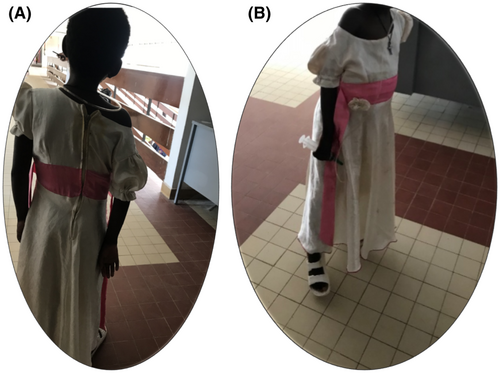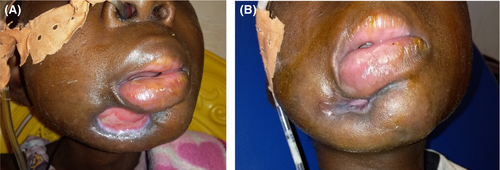Cancrum oris and hemiparesis in a young female patient—a case report
Abstract
Key Clinical Message
Noma is still around today and can be deadly if ignored. Prompt identification and comprehensive care are essential for averting permanent impairments and disfigurements.
Noma is a rapid developing orofacial gangrene and a disabling disease that primarily affects young children who live in dangerous conditions. Underlying diseases such as HIV/AIDS and malnutrition can enhance the likelihood of Noma's emergence. This is a case of a 9-year-old girl patient who arrived malnourished and with an ulcerating communicating right mandibular soft tissue lesion as well as right hemiparesis which had an acute onset. The patient was likewise HIV positive discovered upon admission, possibly as a result of vertical transmission, and was an ART (antiretroviral therapy) treatment naive patient. A holistic treatment plan was installed and a positive clinical response was observed. Early treatment is key in Noma management.
1 INTRODUCTION
Cancrum oris or Noma is an orofacial gangrene and a severe disease that primarily affects young children living in vulnerable circumstances.1 It has been recently added to the list of Neglected tropical diseases by the WHO (World Health Organization) and according to estimates from the WHO, there are 140,000 cases of Noma worldwide, with Sub-Saharan Africa hosting the majority of these cases.2-4 Because Noma is an opportunistic infection, malnutrition, immunosuppression, and diseases such as HIV/AIDS can all enhance the risk of its occurrence.5
Globally, the number of children aged 0–14 living with HIV was estimated to be 930,000 (730,000–1,280,000), with 130,000 (90,000–210,000) newly infected with HIV.6 In 2022, there were 29,000 (21,000–34,000) children ages 0–14 living with HIV in Cameroon, and there were 3400 (2000–4400) new HIV infections among this age group.6
Noma develops quickly and is associated with a number of challenges, including generalized sepsis, intracerebral septic emboli, bronchial aspiration, and inanition. Delayed treatment is not suitable for a restoration to pre-illness state, and this disease causes social marginalization of affected children.7
2 CASE PRESENTATION
A 9-year-old female patient presented with an ulcerating right mandibular soft tissue lesion (Figure 1) and right hemiparesis (Figure 2). The patient was also HIV positive discovered fortuitously after standard workups (viral load of 185 copies/ml confirmed by PCR), ART medication naive, and was malnourished upon arrival.


3 METHODS
She carried out an orthopantomogram which showed a right crescent mandibular radiolucency (Figure 1) from the 36 to the 43 with the basal cortical intact, additionally a well-localized radiolucency at the right maxilla at the apical region of the 14 were detected.
During her stay, she had repeated seizures (absence followed by tonic seizures), prompting us to perform a CT head scan, which indicated to left hypodense lesions in favor of an ischemic stroke (Figure 3).

4 OUTCOME AND FOLLOW-UP
An ART regimen was implemented (Abacavir 600 mg: 1 tablet/24 h, Lamivudine 300 mg: 1 tablet/24 h, and Dolutegravir 50 mg: 1 tablet/24 h) alongside a feeding formula (F-100: 130 mL/kg/24 h [day 1–27] with Vitamin A 200,000 IU every 24 h [day 1–14] and zinc 200 mg: 1 tablet/24 h [day 1–14]), an antibiotic therapy (an association of amoxicillin and clavulanic acid 80 mg/kg/24 h [day 1–3], metronidazole 15 mg/kg/12 h [day 1–15], gentamicin 5 mg/kg/24 h [day 1–6] and ampicillin 200 mg/kg/24 h [day 3–15]) and a twice-daily dressing. A progressive and favorable clinical response was observed as evidenced by a reduction of the soft tissue ulceration and an improved general state (Figure 4).

Her treatment plan was designed to first stabilize her condition by lowering her immunosuppression with an ART regimen, asthenia with a feeding formula, ulceration with antibiotic medication, and dressing twice daily.
Reconstructive surgery was planned but postponed due to a lack of financial means, as was physiotherapy to help her improve her hemiparesis.
5 DISCUSSION
Noma has been shown to affect patients with debilitating diseases and malnourished people as well. This patient was a victim of both and this comorbid interaction could have been fatal to her.
The patient's treatment naivety compromised her immune system and may have also favored the Noma because the latter has been significantly linked to immunosuppression.5
Our patient was treatment naive, and it has been noted that this is not unusual.8 People in western and central Africa are often unaware of their HIV status.9 Noma has reportedly been responsible for the discovery of HIV infections,8 as was also seen in our instance.
In this situation, a mother-to-child transmission was suspected because the patient is an orphan and her mother died shortly after her birth, even though vertical transmission has been reported to be significantly reduced.6
Low-grade chronic inflammation as well as HIV-associated vasculopathies may increase the risk of stroke in HIV patients.10 And more so in our case with treatment naïve immunocompromised patient. Hence, this stroke could be because of the comorbid interaction.
According to the patient and family, this right hemiparesis emerged spontaneously at the age of 6 years, and due to the family's lack of awareness, nothing important was done until she was received at our service 3 years later.
In terms of clinical prognosis, a favorable clinical outcome was observed (Figure 4); however, if left untreated, Noma death rates have been reported to be around 90%.5, 11 Furthermore, HIV-infected Noma patients had a higher mortality rate than HIV-negative patients,5, 12 and these estimates only scratch the surface, as it is estimated that only 10% of affected individuals seek medical care,13 which could be due to inadequate health-care systems, a lack of knowledge about Noma, stigma, and neglect.1
With regards to the radiological work ups an orthopantomogram was carried out to observe the mandibular lesion rather than a 3-dimensional imaging due to financial constraints on the patient's family. And the head CT scan was carried out for free by the hospital.
Because she writes right-handed, the patient will currently have to learn to write with her left hand. Disability-adjusted life years (DALYs) are a typical way to calculate the burden of a disease, and it is estimated that Noma sufferers bear a burden of between 1 and 10 million DALYs.14
This case report is in accordance with the CARE guidelines.15
6 CONCLUSION
Early and holistic therapy is essential for a favorable outcome, as seen in this case report because Noma is an opportunistic infection with underlying diseases, particularly in children. Raising public knowledge about Noma and its consequences will aid in the fight against this disease as well.
AUTHOR CONTRIBUTIONS
Zilefac Brian Ngokwe: Conceptualization; data curation; formal analysis; investigation; methodology; supervision; validation; visualization; writing – original draft; writing – review and editing. Nokam Kamdem Stephane Gimel: Conceptualization; investigation; methodology; writing – original draft. Ntep Ntep David Bienvenue: Conceptualization; investigation; methodology; writing – original draft. Ginette Claude Mireille Kalla: Conceptualization; investigation; writing – review and editing. Bengondo Messanga Charles: Conceptualization; investigation; supervision; writing – review and editing.
ACKNOWLEDGMENTS
The Head of Service and staff of the Odontostomatology and Maxillofacial Surgery Unit of the Yaoundé University Teaching Hospital. The Head of Service and staff of the Pediatrics Unit of the Yaoundé University Teaching Hospital. The Director of the Yaoundé University Teaching Hospital.
FUNDING INFORMATION
None.
CONFLICT OF INTEREST STATEMENT
The authors declare that they have no known competing financial interests or personal relationships that could have appeared to influence the work reported in this paper.
CONSENT
Written informed consent was obtained from the patient's family to publish this report in accordance with the journal's patient consent policy.
Open Research
DATA AVAILABILITY STATEMENT
Data sharing is not applicable to this article as no new data were created or analyzed in this study.




